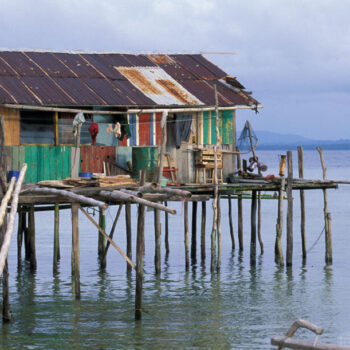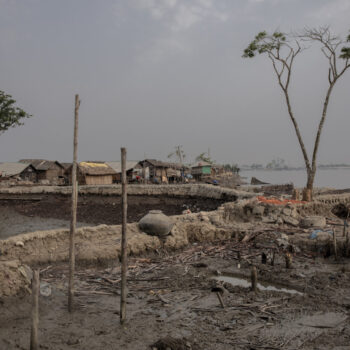For many years, politics have aggravated the rupture between the development and environment communities. Born of different movements and in different generations, often competing for funds and support, a fragmented architecture has evolved that has tended to pit “people” against “planet” and discounted their mutual dependencies and linkages.
Change is in the air, however – and it’s not just climatic. Partly this is owing to the mounting frustration among climate activists at the lack of progress, which has forced campaigners to look to other institutions and processes to complement and catalyse the transition to a low carbon economy.
But partly, too, it is the result of the very political landscape that has traditionally undermined their integration. By a quirk of timetabling, two (potentially) seminal multilateral agreements on climate change and development are due to be signed within a few months of each other – the agreements that will replace the Kyoto Protocol and the Millennium Development Goals (known as “post-2015”) respectively.
The crossover of people and processes, as well as time frames and theory, has spawned opportunities, but also risks. This article offers a quick précis of these and the post-2015 process for people working in the climate sector.
What is the post-2015 development process and what stage is it at?
Since January 2013, the two main arteries of the post-2015 process have been the Open Working Group on Sustainable Development Goals (OWG) and the Intergovernmental Committee of Experts on Sustainable Development Financing (ICESDF). The former is focussed on the nature and content of the goals; the latter on the means of implementation. Both are due to present reports to the General Assembly in September of this year.
Although working in parallel, the OWG and ICESDF are very different beasts. The former is of a more familiar UN mould: 30 seats, most of which are shared by multiple Member States, with meetings held in public and where the watchword is inclusivity. Sessions held by the ICESDF, on the other hand, are ‘closed’ other than cursory, multi-stakeholder briefings; its 30 members are all ‘experts’; and – in part because of these characteristics – its activities have been relatively low profile.
The UN Secretary General will use both reports, as well as contributions from civil society and other UN workstreams, to generate a synthesis report that is due to be issued at the end of 2014. This, in turn, is intended to inform the intergovernmental negotiations that will thrash out the final framework – something that contrives to be short, yet actionable, yet universally applicable, in theory.
How does climate change fit into this picture?
The status of climate change in the OWG’s report remains unsettled. It is listed as one of 16 ‘Focus Areas’ to be discussed in the forthcoming May session, but its relative prominence in the final report is still equivocal.
A sizeable constituency – backed, importantly, by the OWG’s Co-Chairs – argue that the gravity of climate change and its intimate bearings on development mean that only a standalone goal within the framework will afford it sufficient standing and political visibility. This is resisted by those who maintain, amongst other things, that its cross-cutting nature makes climate change better suited to being ‘mainstreamed’ within the targets of other goals; that the post-2015 process risks encroaching on the work of the UNFCCC and/or being contaminated by toxic climate politics; and/or that it is more pragmatic to focus on other issues.
Likewise, the extent to which the ICESDF’s report will – both directly and indirectly – affect climate finance is not clear. The mandate of its work is to consider the whole ‘ecosystem’ of finance, and the Committee’s Co-Chairs are insistent that the report will make ‘transformative’ proposals. The extent to which a 20 page document can effectively direct the re-wiring of the world’s financial flows is, obviously, questionable, especially given the limited involvement of the financial community itself. Nevertheless, the process has instigated some interesting discussions, and – depending on the uptake from those discussions – may help to create the political space for more ambitious action.
What’s the value of the post-2015 process to UNFCCC negotiations?
Given the considerable cross-over of actors and issues, it is clear that the perceived success or failure of the post-2015 process will have important bearings on the politics surrounding COP 21, which will take place less than three months later. A bold, inspiring outcome would restore confidence in the capabilities of global politics and multilateralism. Explicit and unambiguous acceptance that climate stability underpins poverty eradication and global prosperity would also help to disintegrate any remaining artificial divisions between the environmental and development communities.
More specific opportunities to further the climate agenda are also to be had. The negotiating space in the post-2015 process is considerably more expansive than that of the UNFCCC, as it is spared both the pressure of being legally binding and the legacy of perceived failure and mistrust burdening climate negotiations. It therefore offers the chance to refresh the approach to issues that have become stuck in a seemingly impregnable no-man’s land, such as accountability, monitoring and anachronistic divisions between “developed” and “developing” countries. It is also a forum in which to tackle certain climate-related issues head on e.g. to acknowledge that sustainable access to energy is an important priority for vulnerable groups- a matter that is not currently adequately addressed in either the formal or informal climate negotiations.
Likewise, if properly leveraged, post-2015 financial discussions could break the stalemate souring talks on climate finance, which are currently fixated on securing the delivery of the “$100bn pledge”. It is widely accepted that such sums are trivial compared to the costs entailed in mitigation and adaptation, and that considerably greater sums need to be mobilised. The post-2015 financial discussions purport to deliver such transformation: they contemplate the realignment of financial flows both away from high carbon, “unsustainable” development and in support of resilient, low carbon growth.
… and what risks could post-2015 pose to the climate agenda?
Risks associated with post-2015 are not merely those of lost opportunity arising from a failure to secure ambitious, climate-related policies or long-awaited synergies. For those who wish to avoid the hard negotiations of the UNFCCC, post-2015 presents a plausible distraction and diversion of leadership energies, or – more cunningly – a mechanism for process-hopping and demurral.
And while it is probable that negative politics in one process would bleed into the other, it is less clear how a positive outcome in September 2015 would play out in the UNFCCC. It might be spun by some leaders as a flimsy foil for failure in Paris. Moreover, if post-2015 results in further fragmentation of the policy landscape affecting climate change- particularly that relating to climate finance– then far from solving problems, it could actively exacerbate them, by further cramping an already complex and crowded scene and increasing competition for scarce resources.


